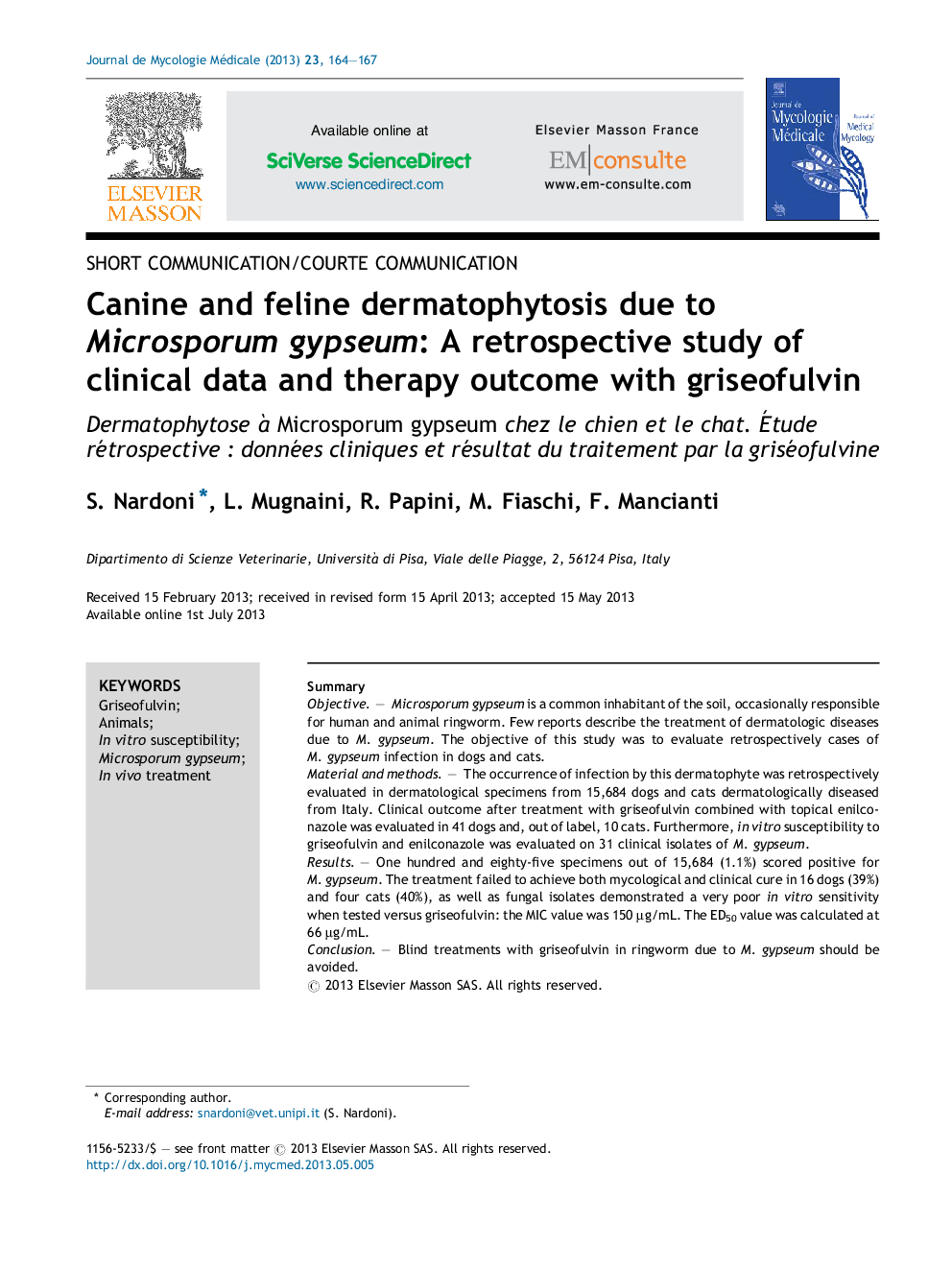| کد مقاله | کد نشریه | سال انتشار | مقاله انگلیسی | نسخه تمام متن |
|---|---|---|---|---|
| 3219515 | 1204449 | 2013 | 4 صفحه PDF | دانلود رایگان |

SummaryObjectiveMicrosporum gypseum is a common inhabitant of the soil, occasionally responsible for human and animal ringworm. Few reports describe the treatment of dermatologic diseases due to M. gypseum. The objective of this study was to evaluate retrospectively cases of M. gypseum infection in dogs and cats.Material and methodsThe occurrence of infection by this dermatophyte was retrospectively evaluated in dermatological specimens from 15,684 dogs and cats dermatologically diseased from Italy. Clinical outcome after treatment with griseofulvin combined with topical enilconazole was evaluated in 41 dogs and, out of label, 10 cats. Furthermore, in vitro susceptibility to griseofulvin and enilconazole was evaluated on 31 clinical isolates of M. gypseum.ResultsOne hundred and eighty-five specimens out of 15,684 (1.1%) scored positive for M. gypseum. The treatment failed to achieve both mycological and clinical cure in 16 dogs (39%) and four cats (40%), as well as fungal isolates demonstrated a very poor in vitro sensitivity when tested versus griseofulvin: the MIC value was 150 μg/mL. The ED50 value was calculated at 66 μg/mL.ConclusionBlind treatments with griseofulvin in ringworm due to M. gypseum should be avoided.
RésuméMicrosporum gypseum est un dermatophyte géophile banal, occasionnellement responsable de teigne humaine et animale. Il y a peu d’information bibliographique sur le traitement des dermatophytoses à M. gypseum. Le but de cette étude était d’analyser rétrospectivement des cas de teigne à M. gypseum chez le chien et le chat.Matériel et méthodesL’infection par ce dermatophyte a été évaluée rétrospectivement grâce à 15 684 échantillons provenant de chiens et de chats atteints de dermatose en Italie. Le résultat du traitement par la griséofulvine combinée à l’énilconazole topique a été évalué chez 41 chiens, et, hors AMM, chez dix chats. De plus, la sensibilité in vitro de 31 souches de M. gypseum d’origine clinique a été évaluée vis-à-vis de la griséofulvine et de l’énilconazole.RésultatsM. gypseum a été identifié dans 185 des 15 684 échantillons (1,1 %). Le traitement n’a pas permis d’obtenir de guérison à la fois clinique et mycologique chez 16 chiens (39 %) et quatre chats (40 %). Les souches isolées ont montré une très faible sensibilité à la griséofulvine, avec une CMI de 150 μg/mL. La valeur de la DE50 était de 66 μg/mL.ConclusionIl est préférable d’éviter l’utilisation empirique de la griséofulvine dans le traitement de la teigne à M. gypseum.
Journal: Journal de Mycologie Médicale / Journal of Medical Mycology - Volume 23, Issue 3, September 2013, Pages 164–167